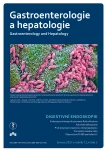Tuberculosis and latent tuberculosis in patients with inflammatory bowel disease treated with biologic agents
Authors:
I. Hricíková; E. Kopecká; V. Polcová; Z. Gyorfy; M. Vašáková
Authors‘ workplace:
Pneumologická klinika 1. LF UK a Thomayerova nemocnice, Praha
Published in:
Gastroent Hepatol 2017; 71(3): 251-255
Category:
Chapters from internal medicine: Review Article
doi:
https://doi.org/10.14735/amgh2017251
Overview
Patients treated with TNF-α inhibitors are at a higher risk of complications owing to infections such as tuberculosis (TB). TB is the third most prevalent infectious disease worldwide. Annually, 8 to 9 million new TB cases are identified and 1.5 million people die of the disease. Every third inhabitant of our planet has been infected with TB. Latent TB infection is the most common form of the disease; however, manifest TB develops in 5–10% of infected subjects. It is possible to prevent progression of latent TB to manifest TB via the use of preventive treatment regimens. Indeed, the diagnosis and treatment of latent TB cases in high-risk populations is the main method of TB elimination in regions with a low incidence of TB, including the Czech Republic. This review focuses on the diagnosis and treatment of latent and manifest TB in patients treated with TNF-α inhibitors. Reactivation of latent TB infection is a major risk for patients treated with anti-TNF-α preparations; therefore, the authors highlight the importance of a scarring examination prior to initiation of therapy. Information about the diagnosis and treatment guidelines for latent and manifest TB infection used in the Czech Republic is also provided in this review.
Key words:
chemoprophylaxis – latent tuberculosis infection – tuberculosis – anti-TNF-α treatment
The authors declare they have no potential conflicts of interest concerning drugs, products, or services used in the study.
The Editorial Board declares that the manuscript met the ICMJE „uniform requirements“ for biomedical papers.
Submitted:
30. 1. 2017
Accepted:
12. 5. 2017
Sources
1. Ústav zdravotnických informací a statistiky ČR. Registr tuberkulózy (RTBC). [online]. Dostupné z: www.uzis.cz/registry/organu-ochrany-verejneho-zdravi/registr-tuberkulozy.
2. Vašáková M. Moderní farmakoterapie. In: Hricíková I, Žáčková P, Vašáková M. Tuberkulóza. 2. vyd. Praha: Maxdorf 2016 : 203–215.
3. Kolek V. Doporučené postupy v pneumologii. 2. vyd. Praha: Maxdorf 2016 : 187–190.
4. Vašáková M. Doporučený postup diagnostiky a léčby latentní tuberkulózní infekce. [online]. Dostupné z: www.pneumologie.cz.
5. Mohan AK, Coté TR, Block JA et al. Tuberculosis following the use of etanercept, a tumor necrosis factor inhibitor. Clin Infect Dis 2004; 39 (3): 295–299.
6. Wallis RS, Broder MS, Wong JY et al. Granulomatous infectious diseases associated with tumor necrosis factor antagonists. Clin Infect Dis 2004; 38 (9): 1261–1265.
7. Jauregui-Amezaga A, Turon F, Ordás I et al. Risk of developing tuberculosis under anti-TNF treatment despite latent infection screening. J Crohns Colitis 2013; 7 (3): 208–212. doi: 10.1016/j.crohns. 2012.05. 012.
8. European Crohn’s and Colitis Organisation. Inflammatory Bowel Diseases. [online]. Available from: www.ecco-ibd.eu/index.php/publications/ecco-guidelines-science.html/vzdelavani/guide-lines.
9. Česká gastroenterologická společnost. Guidelines ČGS. [online]. Dostupné z: www.cgs-cls.cz/vzdelavani/guidelines.
10. Department of Health and Human Services, Centers for Disease Control and Prevention. Updated guidelines for using interferon-gamma release assays to detect Mycobacterium tuberculosis infection. MMWR 2010; 59 (RR-5): 1–25.
11. Homolka J. Doporučení pro biologickou léčbu preparáty blokujícími účinek TNF alfa. [online]. Dostupné z: www.pneumologie.cz.
12. Keane J, Gershon S, Wise RP et al. Tuberculosis associated with infliximab, a tumor necrosis factor alpha-neutralizing agent. N Engl J Med 2001; 345 (15): 1098–1104.
13. Gardam MA, Keystone EC, Menzies R et al. Anti-tumor necrosis factor agents and tuberculosis risk: mechanisms of action and clinical management. Lancet Infect Dis 2003; 3 (3): 148–155.
14. Moyer MT, Groh B. Disseminated tuberculosis after treatment with infliximab. [online]. Available from: www.turner-white.com/memberfile.php?PubCode=hp_nov06_tuber.pdf.
15. Gómez-Reino JJ, Carmona L, Valverde VR et al. Treatment of rheumatoid arthritis with tumor necrosis factor inhibitors may predispose to significant increase in tuberculosis risk. Arthritis Rheum 2003; 48 (8): 2122–2127.
16. Carmona L, Gómez-Reino JJ, Rodriguez-Valverde V et al. Effectiveness of recommendations to prevent reactivation of latent tuberculosis infection in patients treated with tumor necrosis factor antagonists. Arthritis Rheum 2005; 52 (6): 1766–1772.
Labels
Paediatric gastroenterology Gastroenterology and hepatology SurgeryArticle was published in
Gastroenterology and Hepatology

2017 Issue 3
- Metamizole vs. Tramadol in Postoperative Analgesia
- Metamizole at a Glance and in Practice – Effective Non-Opioid Analgesic for All Ages
- Metamizole in the Treatment of Acute Postoperative Pain
- Possibilities of Using Metamizole in the Treatment of Acute Primary Headaches
- Spasmolytic Effect of Metamizole
Most read in this issue
- Rifaximin
- Colonic decompression in daily practice
- Guidelines of the IBD working group of the Slovak Gastroenterology Society on the management of ulcerative colitis
- Difficult diagnostics and serious biliary complications of liver echinococcosis
